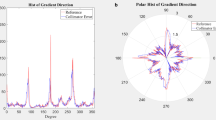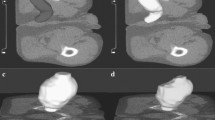Abstract
This study aims to predict isocentric stability for stereotactic body radiation therapy (SBRT) treatments using machine learning (ML), covers the challenges of manual assessment and computational time for quality assurance (QA), and supports medical physicists to enhance accuracy. The isocentric parameters for collimator (C), gantry (G), and table (T) tests were conducted with the RUBY phantom during QA using TrueBeam linac for SBRT. This analysis combined statistical features from the IsoCheck EPID software. Five ML models, including logistic regression (LR), decision tree (DT), random forest (RF), naive Bayes (NB), and support vector machines (SVM), were used to predict the outcome of the QA procedure. 247 Winston–Lutz (WL) tests were collected from 2020 to 2022. In our study, both DT and RF achieved the highest score on test accuracy (Acc. test) ranging from 93.5% to 99.4%, and area under curve (AUC) values from 90 to 100% on three modes (C, G, and T). The precision, recall, and F1 scores indicate the DT model consistently outperforms other ML models in predicting isocenter stability deviation in QA. The QA assessment using ML models can assist error prediction early to avoid potential harm during SBRT and ensure safe and effective patient treatments.









Similar content being viewed by others
References
Brodin NP, et al. Organ-at-risk dose prediction using a machine learning algorithm: Clinical validation and treatment planning benefit for lung SBRT. J Appl Clin Med Phys. 2022;23(6): e13609. https://doi.org/10.1002/acm2.13609.
Song CW, et al. Biological principles of stereotactic body radiation therapy (SBRT) and stereotactic radiation surgery (SRS): indirect cell death. Int J Radiation Oncol Biol Phys. 2021;110(1):21–34. https://doi.org/10.1016/j.ijrobp.2019.02.047.
Lee YC, Kim Y. A patient-specific QA comparison between 2D and 3D diode arrays for single-lesion SRS and SBRT treatments. J Radiosurg SBRT. 2021;7(4):295.
Moustakis C, Ebrahimi Tazehmahalleh F, Elsayad K, Fezeu F, Scobioala S. A novel approach to SBRT patient quality assurance using EPID-based real-time transit dosimetry: a step to QA with in vivo EPID dosimetry. Strahlenther Onkol. 2020;196:182–92. https://doi.org/10.1007/s00066-019-01549-z.
Shariff M, et al. End-to-end testing for stereotactic radiotherapy including the development of a Multi-Modality phantom. Z Med Phys. 2022. https://doi.org/10.1016/j.zemedi.2022.11.006.
Woods K, Rong Y. Technical report: TG-142 compliant and comprehensive quality assurance tests for respiratory gating. Med Phys. 2015;42(11):6488–97. https://doi.org/10.1118/1.4932363.
Du W, et al. A quality assurance procedure to evaluate cone-beam CT image center congruence with the radiation isocenter of a linear accelerator. J Appl Clin Med Phys. 2010;11(4):15–26. https://doi.org/10.1120/jacmp.v11i4.3297.
Valdes G, Morin O, Valenciaga Y, Kirby N, Pouliot J, Chuang C. Use of TrueBeam developer mode for imaging QA. J Appl Clin Med Phys. 2015;16(4):322–33. https://doi.org/10.1120/jacmp.v16i4.5363.
Du W, Johnson JL, Jiang W, Kudchadker RJ. On the selection of gantry and collimator angles for isocenter localization using Winston-Lutz tests. J Appl Clin Med Phys. 2016;17(1):167–78. https://doi.org/10.1120/jacmp.v17i1.5792.
Du W, Gao S. Measuring the wobble of radiation field centers during gantry rotation and collimator movement on a linear accelerator. Med Phys. 2011;38(8):4575–8. https://doi.org/10.1118/1.3609098.
Rowshanfarzad P, et al. Detection and correction for EPID and gantry sag during arc delivery using cine EPID imaging. Med Phys. 2012;39(2):623–35. https://doi.org/10.1118/1.3673958.
Kang H, Patel R, Roeske JC. Efficient quality assurance method with automated data acquisition of a single phantom setup to determine radiation and imaging isocenter congruence. J Appl Clin Med Phys. 2019;20(10):127–33. https://doi.org/10.1002/acm2.12723.
Winkler P, Bergmann H, Stuecklschweiger G, Guss H. Introducing a system for automated control of rotation axes, collimator and laser adjustment for a medical linear accelerator. Phys Med Biol. 2003;48(9):1123. https://doi.org/10.1088/0031-9155/48/9/303.
Valdes G, et al. A mathematical framework for virtual IMRT QA using machine learning. Med Phys. 2016;43(7):4323–34. https://doi.org/10.1118/1.4953835.
Claessens M, et al. Machine learning-based detection of aberrant deep learning segmentations of target and organs at risk for prostate radiotherapy using a secondary segmentation algorithm. Phys Med Biol. 2022;67(11): 115014. https://doi.org/10.1088/1361-6560/ac6fad.
Bedford JL, Hanson IM. A recurrent neural network for rapid detection of delivery errors during real-time portal dosimetry. Phys Imaging Radiation Oncol. 2022;1(22):36–43. https://doi.org/10.1016/j.phro.2022.03.004.
Poppinga D, et al. Evaluation of the RUBY modular QA phantom for planar and non-coplanar VMAT and stereotactic radiations. J Appl Clin Med Phys. 2020;21(10):69–79. https://doi.org/10.1002/acm2.13006.
Chojnowski JM, Sykes JR, Thwaites DI. A novel method to determine linac mechanical isocenter position and size and examples of specific QA applications. J Appl Clin Med Phys. 2021;22(7):44–55. https://doi.org/10.1002/acm2.13257.
Brace OJ, et al. Evaluation of the PTW microDiamond in edge-on orientation for dosimetry in small fields. J Appl Clin Med Phys. 2020;21(8):278–88. https://doi.org/10.1002/acm2.12906.
Valdes G, Scheuermann R, Hung CY, Olszanski A, Bellerive M, Solberg TD. A mathematical framework for virtual IMRT QA using machine learning. Med Phys. 2016;43(7):4323–34. https://doi.org/10.1118/1.4953835.
Kalet AM, Luk SM, Phillips MH. Radiation therapy quality assurance tasks and tools: the many roles of machine learning. Med Phys. 2020;47(5):e168–77. https://doi.org/10.1002/mp.13445.
Cohen I, Huang Y, Chen J, Benesty J, Benesty J, Chen J, Huang Y, Cohen I. Pearson correlation coefficient noise reduction in speech processing. Berlin: Springer; 2009.
Terlizzi M, Limkin E, Sellami N, Louvel G, Blanchard P. Is single fraction the future of stereotactic body radiation therapy (SBRT)? A critical appraisal of the current literature. Clin Transl Radiation Oncol. 2023;25: 100584. https://doi.org/10.1016/j.ctro.2023.100584.
Hanley J, Arjomandy B, Ma L, Aguirre F, AAPM Task Group 198 Report, et al. An implementation guide for TG 142 quality assurance of medical accelerators. Med Phys. 2021. https://doi.org/10.1002/mp.14992.
Chang Z, et al. Imaging system QA of a medical accelerator, Novalis Tx, for IGRT per TG 142: our 1 year experience. J Appl Clin Med Phys. 2012;13(4):113–40. https://doi.org/10.1120/jacmp.v13i4.3754.
Chojnowski JM, Sykes JR, Thwaites DI. Towards zero radiation isocentre size: minimising radiation beam isocentricity on Elekta linear accelerators by means of optimising look-up tables. Phys Eng Sci Med. 2021;44:557–63. https://doi.org/10.1007/s13246-021-00981-9.
H Miura S Ozawa S Tsuda K Yamada Y Nagata 2017. Stability assessment of radiation isocenter with the gimbaled linac system 5 1 3 6
Nyflot MJ, Cao N, Meyer J, Ford EC. Improved accuracy for noncoplanar radiotherapy: an EPID-based method for submillimeter alignment of linear accelerator table rotation with MV isocenter. J Appl Clin Med Phys. 2014;15(2):151–9. https://doi.org/10.1120/jacmp.v15i2.4682.
Kry SF, Jones J, Childress NL. Implementation and evaluation of an end-to-end IGRT test. J Appl Clin Med Phys. 2012;13(5):46–53. https://doi.org/10.1120/jacmp.v13i5.3939.
Solberg TD, et al. Commissioning and initial stereotactic ablative radiotherapy experience with Vero. J Appl Clin Med Phys. 2014;15(2):205–25. https://doi.org/10.1120/jacmp.v15i2.4685.
Zacharopoulos NG, Fenyes DA. A formalism and methodology for measurement and control of LINAC isocenter. J Appl Clin Med Phys. 2023;3: e13981. https://doi.org/10.1002/acm2.13981.
Funding
No specific grant was given to this research by funding organizations in the public, private, or not-for-profit sectors.
Author information
Authors and Affiliations
Contributions
Conceptualization, SS, SAB and LS; methodology, SS, KI; software, MAA.; formal analysis, SS, MAA.; investigation, SS.; resources, LS; data curation, KI; writing—original draft preparation, SS, MAA.; writing—review and editing, SS, LS, MAA. supervision, SAB, LS; visualization, LS. All authors have read and agreed to the published version of the manuscript.
Corresponding author
Ethics declarations
Conflict of intrest
The authors affirm that they do not have any competing interests.
Ethical approval
There are no animal or human subjects used in any of the experiments in this article.
Additional information
Publisher's Note
Springer Nature remains neutral with regard to jurisdictional claims in published maps and institutional affiliations.
About this article
Cite this article
Salahuddin, S., Buzdar, S.A., Iqbal, K. et al. Efficient quality assurance for isocentric stability in stereotactic body radiation therapy using machine learning. Radiol Phys Technol 17, 219–229 (2024). https://doi.org/10.1007/s12194-023-00768-5
Received:
Revised:
Accepted:
Published:
Issue Date:
DOI: https://doi.org/10.1007/s12194-023-00768-5




